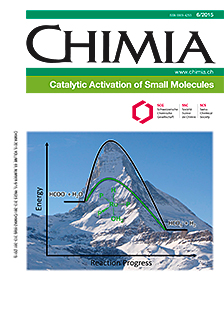Nitrous Oxide-dependent Iron-catalyzed Coupling Reactions of Grignard Reagents
DOI:
https://doi.org/10.2533/chimia.2015.327Keywords:
Grignard reagents, Iron catalysts, Nitrous oxideAbstract
The formation of carbon–carbon bonds is one of the fundamental transformations in chemistry. In this regard the application of palladium-based catalysts has been extensively investigated during recent years, but nowadays research focuses on iron catalysis, due to sustainability, costs and toxicity issues; hence numerous examples for iron-catalyzed cross-coupling reactions have been established, based on the coupling of electrophiles (R1-X, X = halide) with nucleophiles (R2-MgX). Only a small number of protocols deals with the iron-catalyzed oxidative coupling of nucleophiles (R1-MgX + R2-MgX) with the aid of oxidants (1,2-dihaloethanes). However, some issues arise with these oxidants; hence more recently the potential of the industrial waste product nitrous oxide (N2O) was investigated, because the unproblematic side product N2 is formed. Based on that, we demonstrate the catalytic potential of easily accessible iron complexes in the oxidative coupling of Grignard reagents. Importantly, nitrous oxide was essential to obtain yields up to >99% at mild conditions (e.g. 1 atm, ambient temperature) and low catalyst loadings (0.1 mol%) Excellent catalyst performance is realized with turnover numbers of up to 1000 and turnover frequencies of up to 12000 h–1. Moreover, a good functional group tolerance is observed (e.g. amide, ester, nitrile, alkene, alkyne). Afterwards the reaction of different Grignard reagents revealed interesting results with respect to the selectivity of cross-coupling product formation.Downloads
Published
2015-06-24
Issue
Section
Scientific Articles
License
Copyright (c) 2015 Swiss Chemical Society

This work is licensed under a Creative Commons Attribution-NonCommercial 4.0 International License.
How to Cite
[1]
Chimia 2015, 69, 327, DOI: 10.2533/chimia.2015.327.







